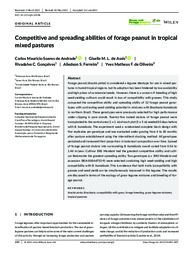Competitive and spreading abilities of forage peanut in tropical mixed pastures.
Competitive and spreading abilities of forage peanut in tropical mixed pastures.
Author(s): ANDRADE, C. M. S. de; ASSIS, G. M. L. de; GONCALVES, R. C.; FERREIRA, A. S.; OLIVEIRA, Y. M. F. de
Summary: Forage peanut (Arachis pintoi) is considered a legume ideotype for use in mixed pastures in humid tropical regions, but its adoption has been hindered by low availability and high prices of commercial seeds. However, there is a concern if breeding of high seed-yielding cultivars could result in loss of compatibility with grasses. This study compared the competitive ability and spreading ability of 12 forage peanut genotypes with contrasting seed-yielding potential in mixtures with Brachiaria humidicola in northern Brazil. These genotypes were previously selected for high performance under clipping in pure stands. Twenty-five rooted stolons of forage peanut were transplanted to the central area (1 × 1 m) of each plot (5 × 5 m) seeded 35 days before with B. humidicola. The experiment used a randomized complete block design with five replicates per genotype and was evaluated under grazing from 6 to 30 months after pasture establishment using the intermittent stocking method. All genotypes persisted and increased their proportion in botanical composition over time. Spread of forage peanut stolons into surrounding B. humidicola sward varied from 0.56 to 1.46 m/year. Cultivar BRS Mandobi had the greatest competitive ability and cultivar Belomonte the greatest spreading ability. Two genotypes (cv. BRS Mandobi and accession BRA-00064752-9) were selected combining high seed-yielding and high compatibility with B. humidicola. This is evidence that both traits (compatibility with grasses and seed yield) can be simultaneously improved in this legume. The results are discussed in terms of the ecology of grass-legume mixtures and breeding of forage peanut.
Publication year: 2021
Types of publication: Journal article
Unit: Embrapa Acre
Keywords: Amendoim forrageiro, Arachis pintoi, Brachiaria Humidicola, Cacauhetes forrajeros, Competición vegetal, Competição de Variedade, Crop yield, Cultivo mixto, Forage grasses, Forage legumes, Forage peanut, Gramínea Forrageira, Leguminosa Forrageira, Leguminosas forrajeras, Mixed cropping, Pastagem, Pastizales, Pastos forrajeros, Pastures, Plant competition, Rendimento, Rendimiento de los cultivos, Urochloa humidicola
Observation
Some of Embrapa's publications are published as ePub files. To read them, use or download one of the following free software options to your computer or mobile device. Android: Google Play Books; IOS: iBooks; Windows and Linux: Calibre.
Access other publications
Access the Agricultural Research Database (BDPA) to consult Embrapa's full library collection and records.
Visit Embrapa Bookstore to purchase books and other publications sold by Embrapa.

